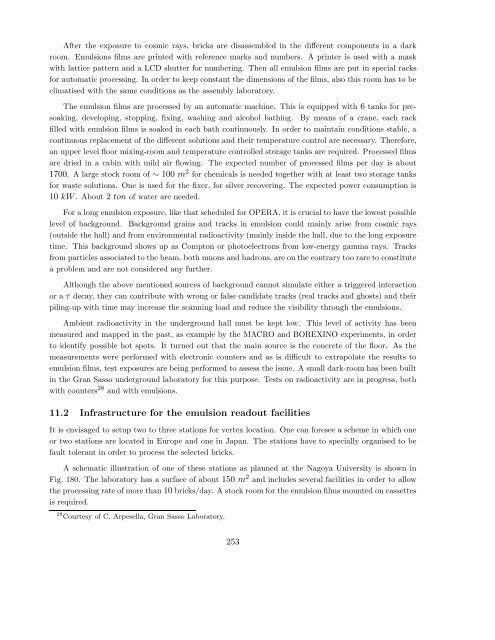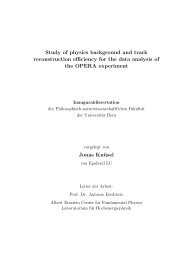Experiment Proposal - opera - Infn
Experiment Proposal - opera - Infn
Experiment Proposal - opera - Infn
Create successful ePaper yourself
Turn your PDF publications into a flip-book with our unique Google optimized e-Paper software.
After the exposure to cosmic rays, bricks are disassembled in the different components in a dark<br />
room. Emulsions films are printed with reference marks and numbers. A printer is used with a mask<br />
with lattice pattern and a LCD shutter for numbering. Then all emulsion films are put in special racks<br />
for automatic processing. In order to keep constant the dimensions of the films, also this room has to be<br />
climatised with the same conditions as the assembly laboratory.<br />
The emulsion films are processed by an automatic machine. This is equipped with 6 tanks for presoaking,<br />
developing, stopping, fixing, washing and alcohol bathing. By means of a crane, each rack<br />
filled with emulsion films is soaked in each bath continuously. In order to maintain conditions stable, a<br />
continuous replacement of the different solutions and their temperature control are necessary. Therefore,<br />
an upper level floor mixing-room and temperature controlled storage tanks are required. Processed films<br />
are dried in a cabin with mild air flowing. The expected number of processed films per day is about<br />
1700. A large stock room of ∼ 100 m 2 for chemicals is needed together with at least two storage tanks<br />
for waste solutions. One is used for the fixer, for silver recovering. The expected power consumption is<br />
10 kW .About2 ton of water are needed.<br />
For a long emulsion exposure, like that scheduled for OPERA, it is crucial to have the lowest possible<br />
level of background. Background grains and tracks in emulsion could mainly arise from cosmic rays<br />
(outside the hall) and from environmental radioactivity (mainly inside the hall, due to the long exposure<br />
time. This background shows up as Compton or photoelectrons from low-energy gamma rays. Tracks<br />
from particles associated to the beam, both muons and hadrons, are on the contrary too rare to constitute<br />
a problem and are not considered any further.<br />
Although the above mentioned sources of background cannot simulate either a triggered interaction<br />
or a τ decay, they can contribute with wrong or false candidate tracks (real tracks and ghosts) and their<br />
piling-up with time may increase the scanning load and reduce the visibility through the emulsions.<br />
Ambient radioactivity in the underground hall must be kept low. This level of activity has been<br />
measured and mapped in the past, as example by the MACRO and BOREXINO experiments, in order<br />
to identify possible hot spots. It turned out that the main source is the concrete of the floor. As the<br />
measurements were performed with electronic counters and as is difficult to extrapolate the results to<br />
emulsion films, test exposures are being performed to assess the issue. A small dark-room has been built<br />
in the Gran Sasso underground laboratory for this purpose. Tests on radioactivity are in progress, both<br />
with counters 28 and with emulsions.<br />
11.2 Infrastructure for the emulsion readout facilities<br />
It is envisaged to setup two to three stations for vertex location. One can foresee a scheme in which one<br />
or two stations are located in Europe and one in Japan. The stations have to specially organised to be<br />
fault tolerant in order to process the selected bricks.<br />
A schematic illustration of one of these stations as planned at the Nagoya University is shown in<br />
Fig. 180. The laboratory has a surface of about 150 m 2 and includes several facilities in order to allow<br />
the processing rate of more than 10 bricks/day. A stock room for the emulsion films mounted on cassettes<br />
is required.<br />
28 Courtesy of C. Arpesella, Gran Sasso Laboratory.<br />
253




